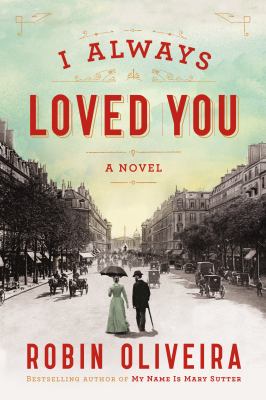Each of us here at the Literary Hoarders read Robin Oliveira’s My Name is Mary Sutter and fell madly in love with it (although Jackie thought the ending was a cop out. ;-) ) The character of Mary Sutter was one of my very favourites and I kept wishing and hoping this book would be made into a mini-series, because it was all I could think about when I was reading it. It would make for a divine mini-series! (Think North and South – am I right?)
Anyway, when I saw that a new novel was out by Oliveria I was beside myself with joy. However, sadly, my over-eagerness and anticipation with having the same love affair for I Always Loved You did not happen. I was anxious for the attachment I thought I would easily form with Mary Cassatt as with Mary Sutter, but, unfortunately, it never happened. I Always Loved You was touted as a book about the love affair between Mary Cassatt and Edgar Degas, yet all of the Impressionists and their lives, love affairs and challenges came out to play in this novel. There was a considerable amount of attention paid to Edouard Manet and Berthe Morisot’s story inside as well. Alternative chapters with Manet and Morisot’s made up much of this novel and sometimes, it felt like more so than about Cassatt and Degas. So, it did have a here, there and everywhere kind of feel to it.
I Always Loved You details much of the daily lives of Degas, Cassatt, Monet, Manet, Morisot – all together in Paris – critiquing each other’s work, in each other’s beds, and it did capture these true struggling and starving artists. Each of them was barely able to pay for food and were all rebuked by the Salon, what was considered the premiere place to show your work. Now, well now, a Monet painting for instance, such as the Le Bassin aux Nymphéas sold for $86.2 million in 2008!
The start of the novel begins very well, it is Mary Cassatt in her advanced age going over letters from Edgar Degas and the end draws the story to an end where we again meet Mary in her old age explaining the unconventional love affair and feelings she held for Degas. It was a touching opening and a lovely end to this story. I would be remiss however if I said I truly enjoyed this one. It failed to capture me in the same way that Mary Sutter did. They are two vastly different subjects, for certain, but it just was not as engrossing nor were the characters as endearing. The story seem to be oft repeated throughout – Mary desperate to be recognized and to be accepted to the Salon. Degas was actually not a great romance, much as others tried to push that into being, she found he frustrated her more or, felt only sincere friendship. He was a person that helped her to become a better painter. While a contentious relationship – much as to be expected of two driven artists – she closes her story expressing fondness and love for the man. He was someone she truly always loved.
Courtesy of marycassat.org, you can watch a slideshow of her complete works http://www.marycassatt.org/slideshow.html, as well as the same for Degas at http://www.edgar-degas.org/
(what struck me in Mary’s work is the vibrant colours and although Degas’ paintings of so many ballet dancers are beautiful, it is a little creepy as well as parts of I Always Loved You touches upon these men that pay the mother’s of these very young dancers to fulfill their pedophilic urges. Cathy Marie Buchanan’s The Painted Girls features this grandly.)


